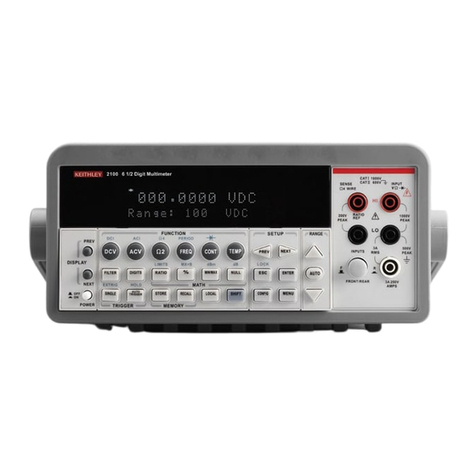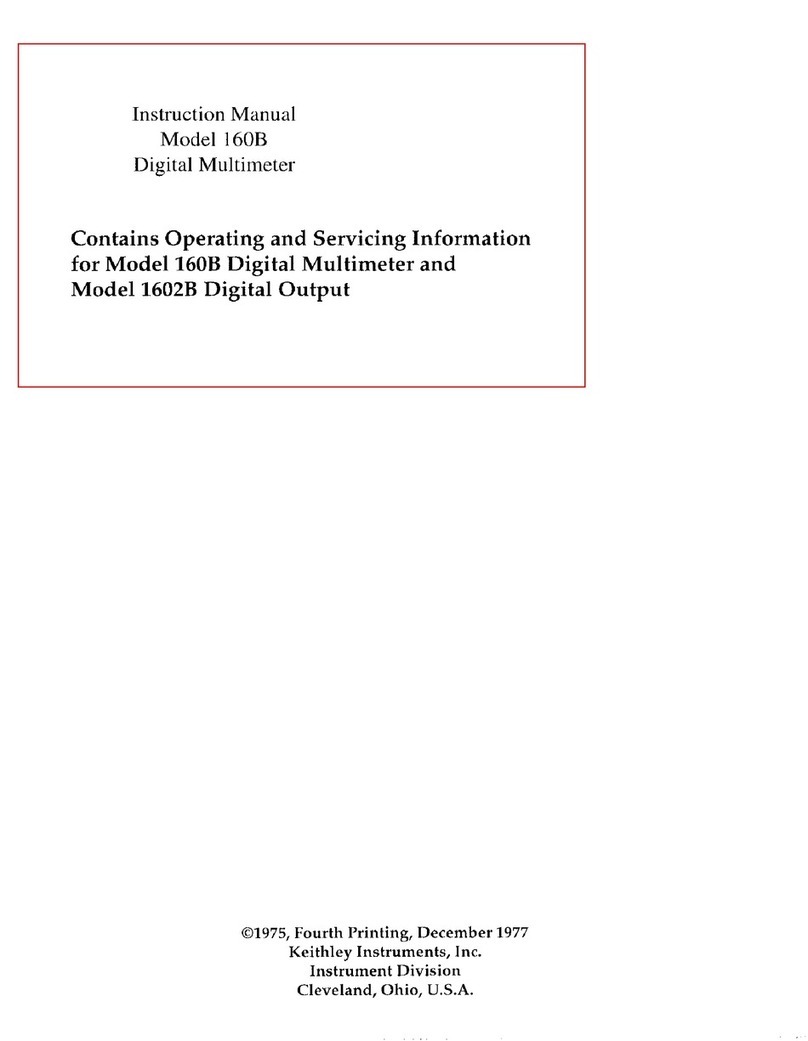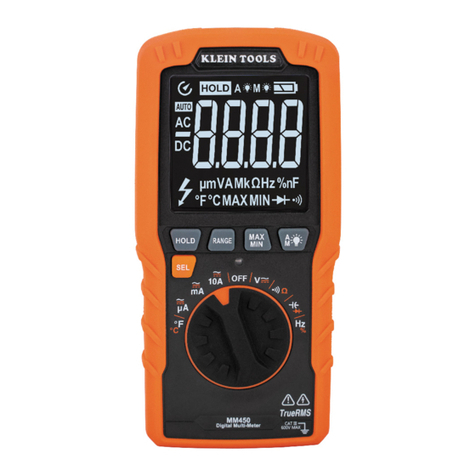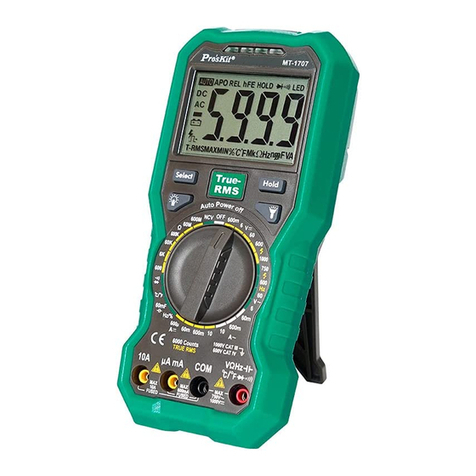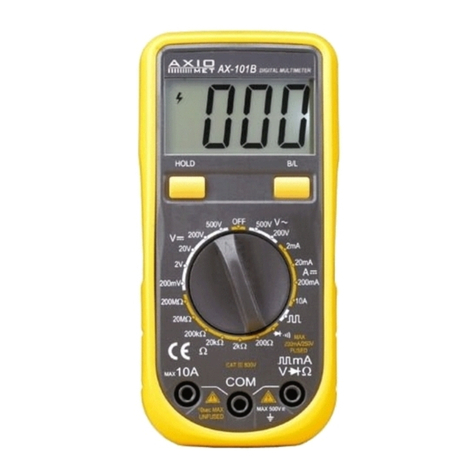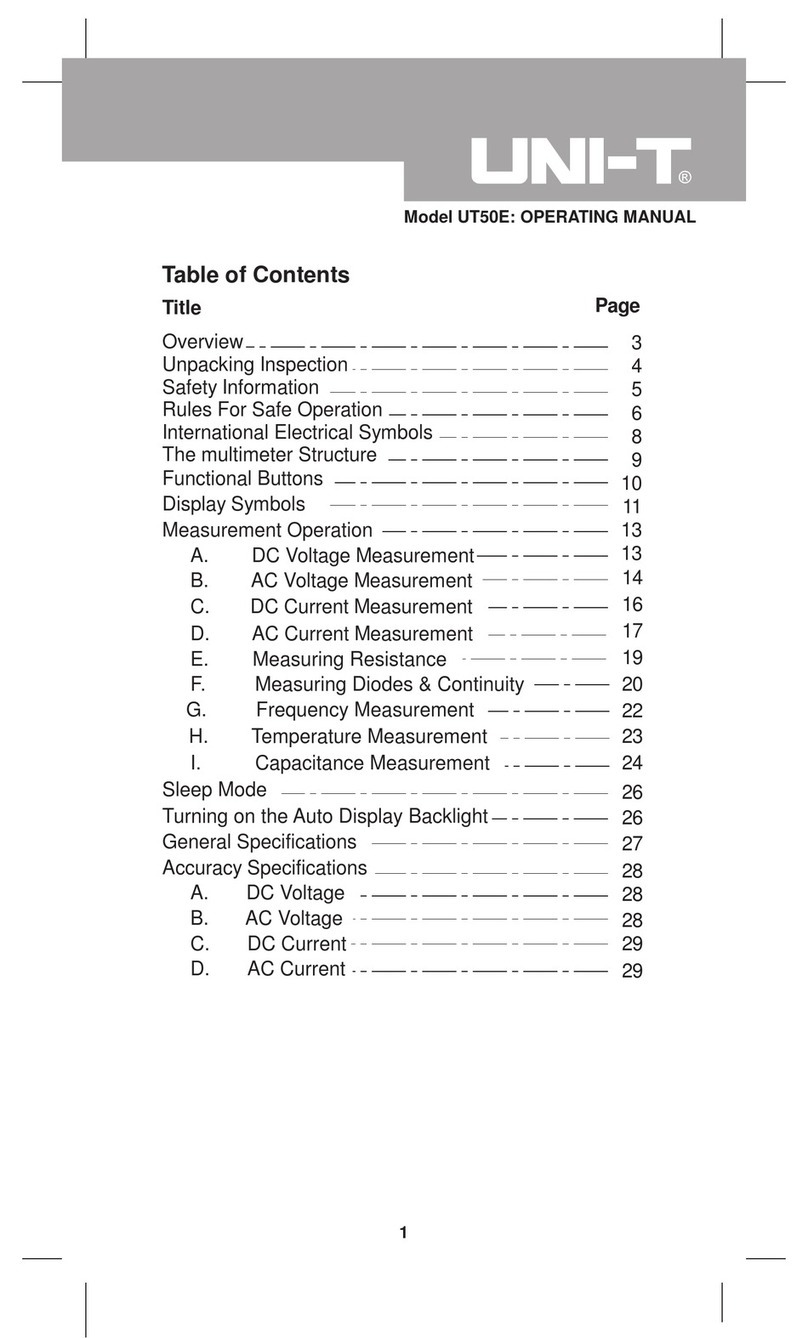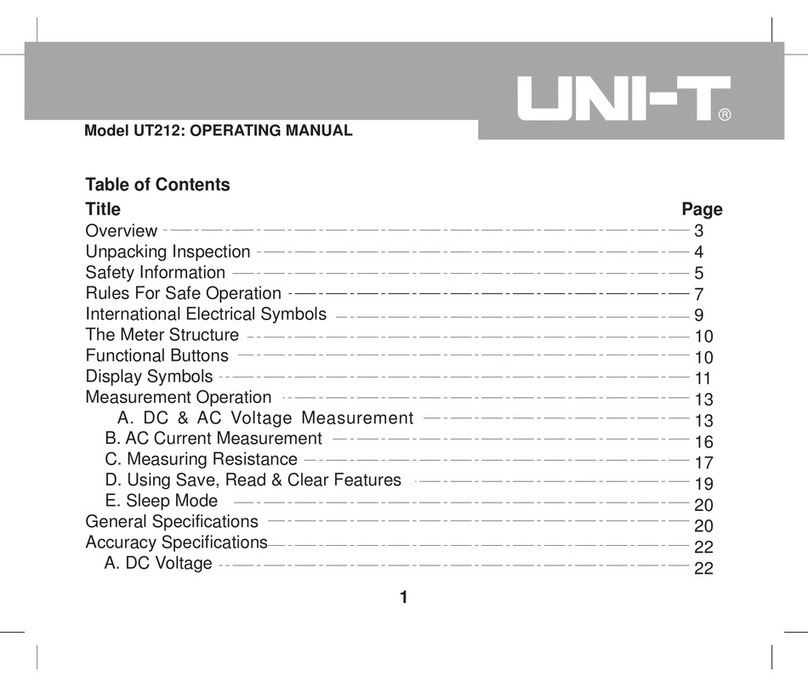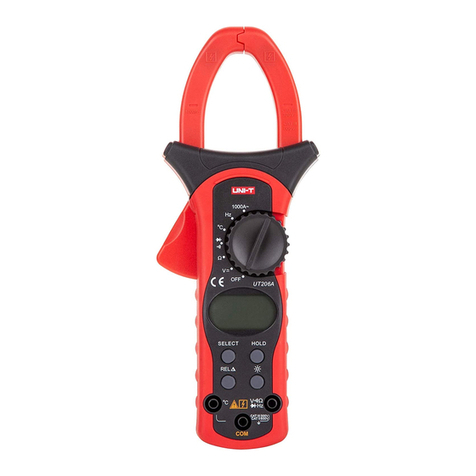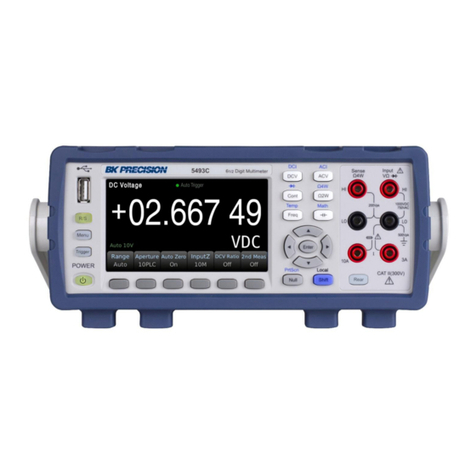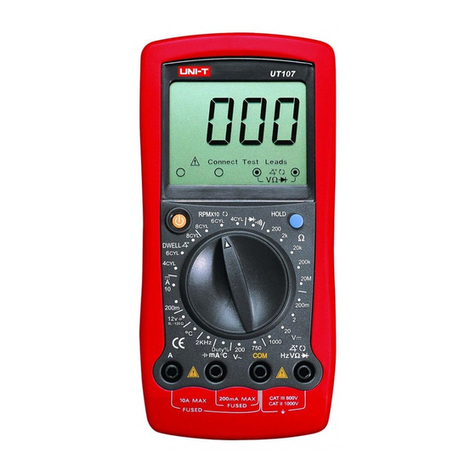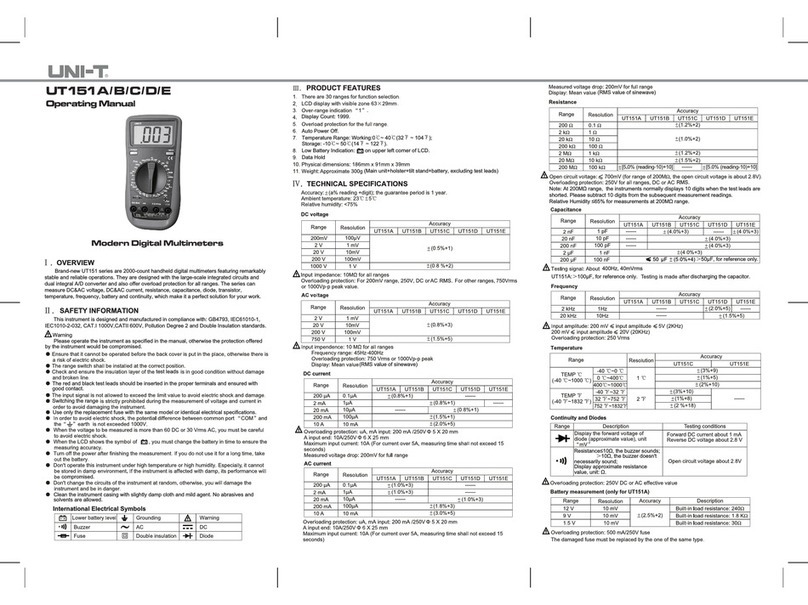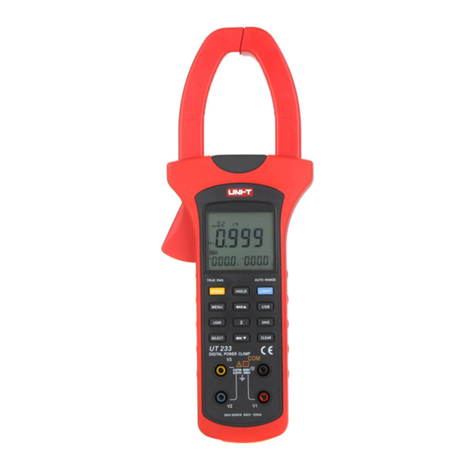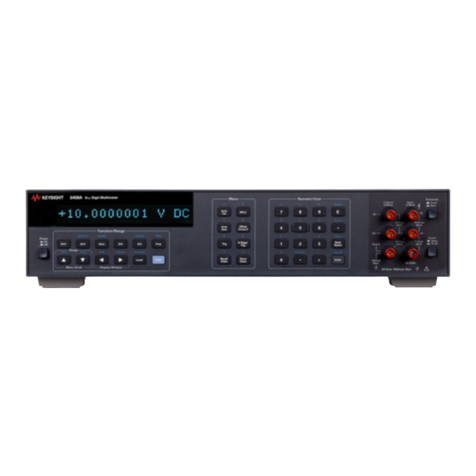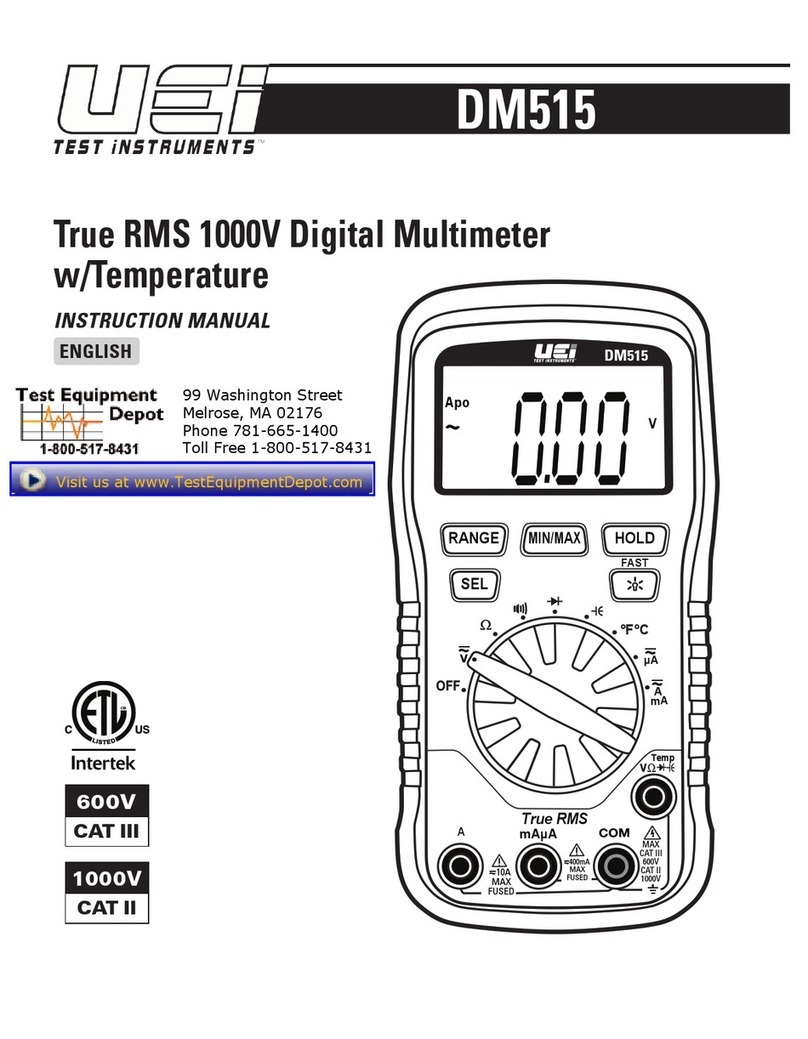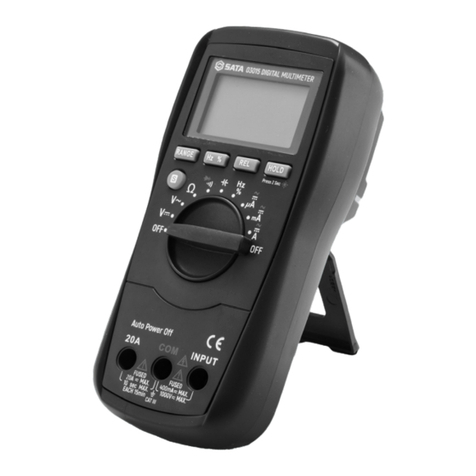Keithley 197 User manual

-~
ARTISAN
®
~I
TECHNOLOGY
GROUP
Your definitive source
for
quality
pre-owned
equipment.
Artisan Technology
Group
Full-service,
independent
repair
center
with
experienced
engineers
and
technicians
on staff.
We
buy
your
excess,
underutilized,
and
idle
equipment
along
with
credit
for
buybacks
and
trade-ins
.
Custom
engineering
so
your
equipment
works
exactly as
you
specify.
•
Critical
and
expedited
services
•
Leasing
/
Rentals/
Demos
• In
stock/
Ready-to-ship
•
!TAR-certified
secure
asset
solutions
Expert
team
ITrust
guarantee
I
100%
satisfaction
All
tr
ademarks,
br
a
nd
names, a
nd
br
a
nd
s a
pp
earing here
in
are
th
e property of
th
e
ir
r
es
pecti
ve
ow
ner
s.
Find the Keithley 197 at our website: Click HERE

Instruction Manual
Model
197
Autoranging Microvolt
DMM
0
Keithley Instruments, Inc.
Cleveland,
Ohio,
U.S.A.
Document Number 197-901-01
Artisan Technology Group - Quality Instrumentation ... Guaranteed | (888) 88-SOURCE | www.artisantg.com

DC
VOLTS
ACCURACY
**
*(%rdg+counts)
RANGE LUTION RESISTANCE 22'-24"C 18"-28'C
200mV
1
rV
>iGR
0.007+2 0.016+3
20
V
100
pV
iiMR
0
m6+2 0.015+2
200
V
ImV
1OMR
0.006+2 0.015+2
loo0
v
1
OmV
1OMR
0.007+2 0.015+2
RESO- INPUT 24
Hr.,*
1 Yr.,
-
2V
10
pV
>
1GR
0
005+2 0.011+2
*Relative to calibration accuracy.
NMRR:
Greater than 6OdB at
50Hz.
60Hz
*0.1%.
MAXIMUM ALLOWABLE INPUT:
lO00V
dc
or
peak ac (less than
10
seconds per
SETTLING TIME
1
second to within 3 counts of final reading
on
range.
dB
MODE
(ref:
ma):
Accuracy: &(0.02dB+I count) above -78dBm. Resolution:
"When properly zeroed.
minute on the 200mV and 2V ranges; 300V rms continuous).
0.OldB above
0.5%
of range
~~
TRMS
"OLTsACCURACY (1
Yr.)
18"-28"C
*(%rdg+counts)
2OHz- 50Hz- lOkHz
-
20kHz
-
50kHz-
RANGE 50Hz* 1OkHz' 20kHz' 50kHz'* 100kHz"
200mV
1.00+100
0.35+100 0.6+200 1.5+250 5+400
2V
-
200V
1.00+700
0.35+100
0.6+200
1.5+250 3+400
~ ~~~ ~~ ~ ~ ~ ~~~
750V
1.25+100
0.75+100 1.0+200 1.8+250 3+400
'Above
1800
counts.
MAXIMUM ALLOWABLE INPUT:
750V
rms,
IOOOV
peak (less than
10
seconds per
3dB
BANDWIDTH:
3JOkHr typical.
INPUT IMPEDANCE:
1MR paralleled by less than 75pF
on
200V and 750V ranges.
1.1MR
paralleled by 75pF on
200mV,
2V and 2OV ranges. Capacitively coupled.
SETTLING TIME:
1
second to within
0.1
%
of final reading on range.
dB
MODE
(ref: 600R):
*'Above
18000
counts.
minute on 200mV and 2V ranges, 300V
rms
continuous). lO'V*Hr maximum.
ACCURACY
(
+-dBm)
20Hz- 10kHz- 20kHz- 5OkHz-
RANGE INPUT lOkHz 20kHz 50kHz 100kHz
2V
-
750V 200mV to 750
V
0.18
0.18 0.28
0.50
(-
12 to 59.8dBmj
(-32 tn -12dBmj
(-52 to -32dBm)
(-58 to -52dBm)
200mV 20mV to 200mV 0.18
0.18
0.28 0.65
2mV to 20mV
0.85
1.10
2.00
~
1mVto 2mV 2.00 3.00
-
-
RESOLUTION:
0.OldB above 0.5%of range.
DC
AMPS
MAXIMUM ACCURACY
(1
Yr.)
VOLTAGE 18"-28'C
RANGE RESOLUTION BURDEN
*(%rdg+counts)
200 uA
1
nA 0.3V
0.1
+15'*
2mA lOnA 0.3V
0.1
+I5
200mA
1
PA 0.3V 0.2
+I5
20mA 100nA 0.3V
0.1
+I5
2000mA
10
pA
0.8V
0.2 +I5
10
A
100
pA 0.3V 0.75+15'
"Above 5A derate
0.15%
rdg per amp for self-heating.
*'When properly rereod.
OVERLOAD PROTECTION: mA
Input: 2A fuse (250V), externally accessible.
SETTLING TIME:
1
second to within
3
count5 of final reading.
10A
Input: 20A for
15s.
unfused.
TRMS
AC
AMPS
ACCURACY
(1
Yr.)*
MAXIMUM 18'-28"c
+(%rdg+counts)
VOLTAGE
RANGE BURDEN ZOHz
-
50Hz 50Hz
-
lOkHz 10kHz
-
30kHz
200pA
-
20mA 0.3V
1.0+100
0.8+100
2
+
250
200mA 0.3V
l.O+IOO
08+100
-
2ooOmA
0.8V
1
OflW
08+100
-
10
A 0.3V
1.5+100**
1.0+100'*
-
*Above1800counts. "1kHz max. Above 5A derate
0.15%
rdglamp for self-heating.
SETTLING TIME:
1
second to within
0.1%
of final reading.
Specifications subject to change without notice
ACCURACY
OHMS
OUTPUT
MAX
v
~
?(%rdg+counts)
RESO- NOMINAL ACROSS 24 HI.. 1
Yr.
RANGE LUTION I-SHORT UNKNOWN 22 -24°C 18
-28°C
200
n
1mR
2mA
05V
001
+2' 002 +3'
2 kR*
1OmR
2mA 4.0
V
0.01
+2
0
018+2
20 kQ lOOmR 400pA 4.0V 0.014+2 0.026+2
200 kR*
1
R
40pA 4.0V 0.014+2 0.026+2
2MR"
10
n
4
aA
4.0V
0.02 +2 0.035+2
20MR"'
100
R
400nA 4.0V
0.10
+2 0.12 +2
200MR**
10
kR
400
nA
5.0V
2.00
+1
2.00
+1
'When properly zeroed.
CONFIGURATION:
Automatic 2-
or
4-terminal.
MAXIMUM ALLOWABLEINPUT:
450V dc
or
peak ac
10
seconds per minute. 350V
OPEN-CIRCUIT VOLTAGE:
+5V.
DIODE TEST:
Display reads junction voltage
up
to 2.2V Test Current: 1.6mA
SETTLING TIME:
2 seconds to within 3 counts of final reading on range.
'*Appropriate range selected automatically in MR.
rms
continuous.
nominal.
GENERAL
DISPLAY:
*220,oo0 count LCD.
0.45
in. height; polarity, function, range. and status
indication.
RANGING:
Auto
or
manual
on
dc volts, ac volts, and ohms: manual on ac amps and
dc amps
RELATIVE:
I'ushbutton allows zeroing of
on
range readings. Allows readings to be
made with respect to baseline value Front panel annunciator indicates REL mode.
DATA LOGGER
and
MIN/MAX:
100
reading storage capacity: records data at one of
six selectable rates from 3 readingslsecond to
1
reading;hour
or
by manual trigger-
ing. Also detects and stores maximum and minimum readings continuously while
in
data logger mode.
CONVERSION RATE:
3 readings/second.
OVERRANGE INDICATION: "OL"
displayed.
CREST FACTOR
(ratio
of
peak value to rms value),
AC FUNCTIONS:
3.
MAXIMUM COMMON MODE VOLTAGE:
500V
peak
COMMON MODE REJECTIONRATIO (1kR
unbalance): Greater than 12OdB at dc,
SOHr, 6OHz
+0.1%.
Greater than 6OdB in ac volts.
TEMPERATURE COEFFICIENT(Oo-lS0C
&
28 -50-C):
*
(0.1
X
applicable one year
accuracy specification)/'C.
ENVIRONMENT:
Operating: O"-5O0C;less than
80%
relative humidity up to 35'C:
linearily derate 3% RH/"C, 35"-50"c. Storage: -25' to 60-C.
WARMUP:
1
hour to rated accuracy.
POWER:
105-125V or 210-25OV (external switch selected).
90-llOV
available;
DIMENSIONS, WEIGHT:
89mm high
X
235mm wide
X
275mm deep (31
2
in.
X
91
4
ACCESSORIES SUPPLIED:
Model 1751 safety te5t leads, instruction manual.
ACCESSORIES AVAILABLE:
50-60Hz,
12V.A. Optional 5-hour battery pack, Model 1978.
in.
X
10%
in.). Net weight 1.8kg
(3
Ibs., 14
OL
1.
Model
1010:
Model 1017:
Model 1301: Temperature Probe
Model 1600A. High Voltage Probe
Model 1641
:
Model 1651: 50-Ampere Current Shunt
Model
1681:
Model 1682A: RF Probe
Model 1684:
Model
1685:
Clamp-On Ac Probe
Model 1751: Safety Test Leads
Model 1754:
Model 1972:
Model 1973: IEEE-488 Interface
Model 1978: Rechargeable Battery Pack
Model 7008-3: IEEE-488Digital Cable (3
ft
)
Model 7008-6: IEEE-488 Digital Cable
(6
it.)
Model 8573.
Single Rack Mounting Kit
Dual Rack Mounting Kit
Kelvin Test Lead Set
Clip-On Test Lead Set
Hard Shell Carrying Case
Universal Test Lead Kit
IEEE-488 with Analog Output
IEEE-488 Interface for IBM
IT
(use with 1972l3)
Artisan Technology Group - Quality Instrumentation ... Guaranteed | (888) 88-SOURCE | www.artisantg.com

TABLE
OF
CONTENTS
SECTION 1-GENERAL INFORMATION
1.1
1.2
1.3
1.4
1.5
1.6
1.7
1.8
1.9
1.10
2.1
2.2
2.3
2.3.1
2.3.2
2.3.3
2.4
2.4.1
2.4.2
2.4.3
2.4.4
2.5
2.6
2.6.1
2.6.2
2.6.3
2.7
2.7.1
2.7.2
2.7.3
2.7.4
2.7.5
2.7.6
2.7.7
2.7.8
2.7.9
2.7.10
2.7.11
2.7.12
2.8
2.8.1
2.8.2
2.8.3
2.8.4
Introduction
...........
......................................................
1-1
Features
..............................................
..........
1-1
Warranty Information
1-1
ManualAddenda
......................................
..........
1-1
Safety Symbols and Terms.
..............................
.................
1-1
Specifications
.........................................
.........
..........
1-2
Unpacking and Inspection
.
......................................................
1-2
Using the Model
197
Manual
.............................
.....................
1-2
Initial Operation
... ................................................................
1-2
....
......................................................
...
Accessories
......................
SECTION 2-BENCH OPERATION
Introduction
....................
...........................................
2-1
High Energy Circuit SafetyPrecautions
...............................
........
2-1
Preparation For Use
.....
......................................................
2-1
LinePower
.........................................
..........
2-1
BatteryPackPower
..................................................................
2-2
Battery Charging.
....................................
......................
2-2
Front Panel Familiarization
....................
..........
2-2
Display
..................................
.................................
2-2
Front Panel Controls
............................................
.................
2-3
Input Terminals
...
...........................................................
2-3
Current Fuse Replace
................
.....................
2-3
ErrorMessages
..............................................................
......
2-4
Operating Conditions.
...
......................................................
2-4
Environmental Conditions
.............................
..........
2-4
Maximum Allowable Inputs
......................................................
2-4
WarmUp
......
.....................
2-4
Basic BenchMeasurements
..............................
..................
2-4
PowerUp
.....................
2-5
RelativeMode
................................
..................
2-5
ent
..................
...........
.....................
2-6
TRMS
AC
Voltage Measurements
......................
..................
2-6
Microvolt Measurement Considerations
...........................................
2-7
ResistanceMeasurements
..............................
......................
2-8
Current Measurements (DCorTRMS
AC)
...............
......................
2-9
AC Plus
DC
Measurements
..........
..........................................
2-10
dB Measurements
..............
dB Measurements Considerations and Applicatio
MIN/MAXand
100
Point Data Logger Operatio
Diode Test
....................
................................
...........................................
TRMS
Considerations
.
..........................................
2-13
AC
Voltage Offset
.............
.........
2-14
TRMS
Measurement Comparison
......................................................
2-14
CrestFactor
.........................................
....................
2-14
Extended Frequency Response
.......................
....................
2-14
i
Artisan Technology Group - Quality Instrumentation ... Guaranteed | (888) 88-SOURCE | www.artisantg.com

SECTION
3-
PERFORMANCE VERIFICATION
3.1
3.2
3.3
3.4
3.5
3.5.1
3.5.2
3.5.3
3.5.4
3.5.5
4.1
4.2
4.3
4.3.1
4.3.2
4.3.3
4.3.4
4.3.5
4.3.6
4.4
4.4.1
4.4.2
4.4.3
4.4.4
4.5
4.6
4.7
5.1
5.2
5.3
5.4
5.5
5.5.1
5.5.2
5.6
5.6.1
5.6.2
5.6.3
5.6.4
5.6.5
5.6.6
5.6.7
5.6.8
5.7
5.7.1
5.7.2
5.7.3
-___
...
3-1
Introduction
........................................................
Environment itions
.................................................
3-1
Recommended Test Equipment
..................
............................
3-1
Initial Conditions
.............................
...................
Verification Procedure
........
..................................................
3-1
DCVoltage Accuracy Check
..................... ............................
3-2
AC Voltage Accuracy Check
...........
............................
3-2
ResistanceAccuracy Check
............
.....................................
3-3
DC Current Accuracy Check
...........
AC Current Accuracy Check
.............
..................................
3-5
......
..
.......................
SECTION 4-THEORY OF OPERATION
Introduction
..................................................
.............
4-1
Overall Functional Description
........................................................
4-1
Analog Circuitry.
........................
.....................................
4-1
Multiplexer
................
4-1
Input BufferAmplifier
.......
.................................................
4-1
................................................
........................
4-1
......................................................
4-1
...........................
4-4
AC Converter
.......................................................
4-5
............................
4-5
......
4-5
...........................................
4-6
PIA
.................................................
........................
4-6
Display Board
.....
.....
.................................................
Digital Calibration
......................
.................
4-6
Model
1978
Battery Option
. . ......................................................
4-7
SECTION 5-MAINTENANCE
Introduction
....................................
............................
5-1
TopCover Removal/Installation
...................
............................
5-1
....
5-2
Battery Pack (Model
1978)
Installation
...............
.............................
5-1
Line Voltage Selection
.................................................
Fuse Replacement
....
........................................
5-2
LineFuse Replacement
....................................
....................
5-2
Current Fuse Replacement
.
......................................................
5-2
Front Panel Calibration
.................
........................................
5-4
Recommended Calibration Equipment
.....................
........................
5-4
.......
5-4
Environmental Conditions
...........................................
Calibration Jumper
........................
...................................
5-4
DCVoltage Calibration
............................................. ............
5-5
ACVoltage Calibration
.................
......................................
5-5
Frequency Compensation.
.....................................
...............
5-5
ResistanceCalibration
...............
........................................
5-7
Calibration Storage
.......................................
...................
5-7
Troubleshooting
........................
.......................................
5-8
PowerUpSequence
............................... ............................
5-8
Self DiagnosticProgram
..........
5-8
ild
Power Supply and Battery Pack (Model
1978)
Checks
......................................
.............................................
5-9
ii
Artisan Technology Group - Quality Instrumentation ... Guaranteed | (888) 88-SOURCE | www.artisantg.com

5.7.4
5.7.5
Signal Conditioning
.......................
5.8
Special Handling of Static SensitiveDevices
.....
A/DConverter and Display
................
6.1
6.2
6.3
6.4
6.5
SECTION 6-REPLACEABLE PARTS
Introduction
..............................
Replaceable Parts
..........................
Ordering Information
.......................
Factory Service
............................
..
..
..
.......
.......
.......
.......
......
......
......
..
..
..
..
......................
......................
......................
......................
......................
......................
......................
Schematic Diagrams and Component Location Drawings
.........................
...
...
....
...
...
...
...
...
......
5-9
......
5-9
......
5-9
..
..
........
6-1
......
6-1
......
6-1
......
6-1
....
6-1
...
Ill
Artisan Technology Group - Quality Instrumentation ... Guaranteed | (888) 88-SOURCE | www.artisantg.com

LIST
OF
TABLES
2-1
2-2
2-3
2-4
2-5
2-6
2-7
3-1
3-2
3-3
3-4
3-5
3-6
5-1
5-2
5-3
5-4
5-5
5-6
5-7
5-8
5-9
5-10
6-1
6-2
6-3
ErrorMessages
.........
2-4
Model 197Maximum Allowable Inputs
.................................
2-5
dB Specificationfor DCVolts (600flRef)
............................. ................
2-10
Comparison of Average and
TRMS
Meter Readings
......................................
2-15
.........................................................
.......
ResistanceRange Output Values
..........................................................
dB Specificationfor AC Volts (600flRef)
..................................................
Levels for Other ReferenceImpedances
...................................................
2-8
2-11
2-12
Recommended Test Equipment
...........................................................
3-1
Limitsfor AC Voltage Verification
........................................................
3-3
Limitsfor ResistanceVerification
................................................
....
3-3
Limitsfor DC Current Verification
............
......................
3-4
Limits for DCVoltage Verification
..............
......................
3-2
Limitsfor AC Current Verification
........................................................
3-6
Recommended Calibration Equipment
.....................................................
DC Voltage Calibration
...............................................
........
ACVoltageCalibration
.................................................................
ResistanceCalibration
................................................
..........
Recommended Troubleshooting Equipment
.................................................
Model 197Troubleshooting Mode
.....................................
Power Supply and Battery Pack (Model1978)Checks
.......................................
DisplayBoardChecks
.................................................................
A/DConverter Checks
...............................
..............
Model 197Static Sensitive Devices
.......................................................
........
5-4
5-5
5-6
5-7
5-8
5-10
5-12
5-12
5-13
5-13
Model197PartsList
....................................................................
6-3
Display Board. Parts List
................................................................
6-6
Model 1978Battery Pack. PartsList
.......................................................
6-6
iv
Artisan Technology Group - Quality Instrumentation ... Guaranteed | (888) 88-SOURCE | www.artisantg.com

LIST
OF
ILLUSTRATIONS
2-1
2-2
2-3
2-4
2-5
2-6
2-7
2-8
2-9
3-1
3-2
3-3
3-4
3-5
3-6
3-7
3-8
4-1
4-2
4-3
4-4
4-5
4-6
5-1
5-2
5-3
5-4
5-5
5-6
5
-7
6-1
6-2
6-3
6-4
6-5
6-6
6-7
Model 197Front Panel
.......................
.................................
2-2
DCVoltageMeasurements
...................
.................................
2-6
TRMSACVoltage Measurements
........................................................
2-7
TwoTerminal ResistanceMeasurement
.... ....................
2-9
Four Terminal ResistanceMeasurement
....
....................
2-9
Four Terminal Zeroing
.........
.................................
2-9
Current Measurements Between 2
.........................................
2-10
Current Measurements up to 2000mA
.........
................................
2-10
Typical ACV Frequency Response
.......................................................
2-15
Connections for
DCV
Verification
...
..................
3-2
Connections for ACV Verification
...
..................
3-3
Connections for 200, 2k and 20k Range
...............................
3-4
Connections
for
200k through MU RangesVerification (2-Terminal)
............................
3-4
Connections for DCCurrent Verification (200pAto 2000mA)
..................................
3-5
Connections for DC Current Verification (2000mAto 20A)
...................................
3-5
Connections forAC Current Verification (200pAto2000mA)
..................................
3-6
Connections forAC Current Verification (2OOOmA to 10A)
...................................
3-6
SimplifiedBlock Diagram
....
........................................................
4-2
4-3
Input Configuration During 2- and 4-Terminal ResistanceMeasurements
........................
4-4
ResistanceMeasurement SimplifiedCircuit
.................................................
4-5
A/DConverter
................................................
4-6
JFETMultiplexer
............
........................................................
4-3
SimplifiedSchematic of the Input BufferAmplifier
..........................................
...........
5-3
DCI
I<TJ~:II
ON
REVISION
C
........
................................................
5-5
5-5
DC Voltage Calibration Configuration
...................................................
5-7
AC Voltage Calibration Configuration
...................................................
...........
5-7
200, 2k and 20k Four Wire Resistance Calibration
..........
...
200k. 2M and 20M
Two
Wire Resistance Calibratic
.............................
3-7
Segment Identification
...............................
...............
5-9
Model
197
Miscellaneous Parts
....
.................................................
Display Assembly, Exploded View
................................................
6-1
.........
6-7
6-11
.............................
6-15
.................
6-17
Model 1978Battery Pack, Compone
Mother Board, SchematicDiagram, Dwg
.
No
.
197-106
......
................
.......
6-13
Model 1978Battery Pack, Schematic Diagram, Dwg
.
No
.
1978-106
......
ion Drawing, Dwg
.
No
.
1978-100
. .
Mother Board, Component Location Drawing, Dwg
.
No
.
197-100
............
Display Board, Component Location Drawing, Dwg
.
No
.
197-110
.............................
Display Board, Schematic Diagram, Dwg
.
No
.
197-116
.....
vlvi
Artisan Technology Group - Quality Instrumentation ... Guaranteed | (888) 88-SOURCE | www.artisantg.com

SAFETY
PRECAUTIONS
The following safety precautions should be observed before operating the Model
197.
This instrument is intended for use by qualified personnel who recognize shock hazards and are familiar with the
safety precautions required to avoid possible injury. Read over the manual carefully before operating this instru-
ment.
Exercise extreme caution when a shock hazard is present at the instrument's input. The American National Stan-
dards Institue (ANSI)states that a shock hazard exists when voltage levels greater than 30V rms
or
42.4V peak are
present.
A
good safety practice is to expect that a hazardous voltage
is
present in any unknown circuit before
measuring.
Inspect the test leads for possible wear, cracks or breaks before each use.
If
any defectsare found, replace with test
leads that have the same measure of safety as those supplied with the instrument.
For optimum safety donot touch the test leads or the instrument while power is applied to the circuit under test.
Turn the power off and discharge all capacitors, before connecting or disconnecting the instrument. Always
disconnect all unused test leads from the instrument.
Do
not touch any object which could provide a current path to the common side of the circuit under test or power
line (earth)ground. Always make measurements with dry hands while standing on a dry, insulated surface,
capable
of
withstanding the voltage being measured.
Exerciseextreme safety when testing high energy power circuits (ACline
or
mains, etc).Refer to the operation sec-
tion.
Do
not exceed the instrument's maximum allowable input as defined in the specifications and operation section.
Artisan Technology Group - Quality Instrumentation ... Guaranteed | (888) 88-SOURCE | www.artisantg.com

SECTION
1
GENERAL INFORMATION
1.1
INTRODUCTION
The Model 197 is a six function,
5?h
digit resolution
autoranging digital multimeter with a
+-220,000
count LCD
(Liquid Crystal Display). This
A/D
range is greater than the
normal +-199,999count
A/D
used in many
5?h
digit DMMs.
The
5%
digit resolution allows the Model 197to measure
DC
voltage from 1pV/count to
1OOOV.
AC
voltage and current
measurements are standard in the Model 197. TRMS ACV
capability ranges from IpVlcount to
750V.
The Model 197
measures resistance from 1mQto 220MQ on seven resistance
ranges. The Model 197 has six current ranges that measure
current from 1nA (lO-9A) to 10A.
The dB function makes
it
possible to compress a large range
of readings into a much smaller scope. The Model 197 dBm
measurements are referenced to the standard
600Q
impedance
but can be modified with the use of relative
(REL)
feature.
The Model 197 has two IEEE-488 interface options: The
Model 1972 and the Model 1973. These optional interfaces
enhance the capabilties of the Model 197 by allowing pro-
grammed control over the IEEE-488 bus. TheModel 1972also
includes an analog output. The bus commands are the same
for each interface and respond to IEEE-488 protocol.
6.
5%
Digit Resolution-The Model 197 has a +220,000
count A/D that surpasses the more common k199,999
count A/D.
7.
Four
Terminal Ohms-These terminals are used to
eliminate the voltage drop across the current carrying
leads.
8.
Sensitivity-The Model 197has 1pV, ImQand 1nA sen-
sitivity. The IpV of sensitivity allows minute levels of off-
set, temperature etc. A 1nA sensitivity allows low current
measurements without special equipment. Measure
leakage, bias and offset current. A ImQsensitivity allows
easy low resistance measurements.
1.3
WARRANTY INFORMATION
Warranty information may be found on the inside front cover
of this manual. Should
it
become necesary to exercise the
warranty, contact your Keithley representative
or
the factory
to determine the proper course of action. Keithley In-
struments maintains service facilities in the United States,
United Kingdom and throughout Europe. Information con-
cerning the application, operation
or
service of your instru-
ment may be directed to the applications engineer at any of
these locations. Check the inside front cover for addresses.
1.4
MANUAL ADDENDA
1.2
FEATURES
The Model 197 includes the following features:
1.
2.
3.
4.
5.
Six Measurement Functions-DCV, ACV, DCA, ACA,
OHMS
and dB all built in.
(REL)Relative Mode-The relative mode allows offsets to
be nulled out (e.g. test lead resistance for low resistance
measurements) and selects a variety of reference im-
pedances for dB measurements.
Digital Calibration-A non-volatile
RAM
stores calibra-
tion constants and can be performed from the front panel
or
over the IEEE-488 bus.
Data Logger-A data storage buffer is included to allow
up to
100
readings and minimum/maximum readings be
internally stored at a user selectable rate. The buffer may
be read and controlled from the front panel
or
over the
IEEE-488 bus. In the talk-only mode, the output rate can
also be programmed.
Autoranging-The Model 197includes a fast autoranging
feature for easier measurements.
Information concerning improvements or changes to this in-
strument which occur after the printing
of
this manual will be
found on an addendum sheet included with this manual. Be
sure to review these changes before attempting to operate
or
service the instrument.
1.5
SAFETY SYMBOLS AND TERMS
The following safety symbols and terms are used in this
manual or found on the Model 197.
The symbol
A
on the instrument denotes the user should
refer to the operating instructions in this manual.
The symbol &n the instrument denotes that a potential
of
1OOOV
or
more may be present on the terminal(s). Stand-
ard safety practices should be observed when such dangerous
levels are encountered.
1-1
Artisan Technology Group - Quality Instrumentation ... Guaranteed | (888) 88-SOURCE | www.artisantg.com

The
WARNING
heading used in this manual explain dangers
that could result in personal injury
or
death.
The
CAUTION
heading used in this manual explain hazards
that could damage the instrument.
1.6 SPECIFICATIONS
Detailed Model 197 specifications may be found preceding
the table of contents of this manual.
1.7 UNPACKING AND INSPECTION
The Model 197 Autoranging Microvolt DMM was carefully
inspected, both electrically and mechanically before ship-
ment. Upon receiving the instrument, carefully unpack all
items from the shipping carton and check for any obvious
signs of physical damage that may have occurred during tran-
sit. Report any damage to the shipping agent. Retain and use
the original packing materials in case reshipment is necessary.
The following items are shipped with every Model 197order:
Model 197 Autoranging DMM
Model 197 Instruction Manual
Model 1751 Safety Shrouded Test Leads
Additional accessories as ordered.
If
an additional instruction manual is required, order the
manual package (Keithley Part Number 197-901-00). The
manual package includes an instruction manual and any ap-
plicable addenda.
1.8 USING THE MODEL 197 MANUAL
This manual contains information necessary for operating
and servicing the Model 197 Autoranging Microvolt DMM
and the Model 1978Rechargeable Battery Pack. The informa-
tion is divided into the following sections.
1.
Section 2 contains detailed bench operation information
for the Model 197.
2. Section
3
contains the information needed to verify the ac-
curacy of the Model 197. Performance verification can be
done upon receipt of the unit
or
whenever the basic ac-
curacy of the instrument is in question.
3.
Information concerning theory of operation, maintenance
and servicing is contained in Sections 4 through
6.
NOTE
The Models 1973 and 1972 IEEE-488 interfaces
come supplied with their own instruction
manual.
1.9 INITIAL OPERATION
Perform the following steps in sequence to acquaint yourself
with the basic operation of the Model 197.
Verify that the instrument was not damaged in transit, (see
paragraph 1.7).
Carefully read over all safety information (see Section
2
Basic Operation).
Refer to paragraph 2.3 (LinePower)and set the line voltage
switch. Plug the power cord into a properly grounded
receptacle. If the Model 1978is installed the charging circuit
is activated.
Acquaint yourself with the front panel controls as follows:
1.
Turn on the instrument using the ON/OFF button. All of
the zeroes are briefly displayed.
2. Connect the supplied test leads to the HI and
LO
input ter-
minals. Connect the red test lead to the HI terminal and
the black test lead to the
LO
terminal. Short the test leads
together.
3. Select AC volts and autoranging by pressing in the
AC/DC, V and AUTO buttons. The AC, AUTO and mV
annunciators are displayed. Pressing in any of the other
range buttons activates manual ranging. This is indicated
by the absence of the AUTO annunciator.
4. Select DC volts by releasing (out position) the AC/DC
button.
V
is still selected. The AC annunciator turns off.
5.
Select the autoranging OHMS by pressing in the AUTO,
and
3
buttons. DC must still be selected. The
3
(omega)
symbol is displayed. Press the AC/DC button in (means
select AC) and note that the "Err" message is displayed.
This indicates an invalid mode.
6.
SelectAC or DC current by setting the AC/DC button ac-
cordingly and pressing in the A button. The annunciator
that reflects the selected mode
is
displayed. Note that cur-
rent will not autorange. The 10A and
LO
terminals must
be used on the 10A range.
7. Select dB by selecting AC
or
DC volts and pressing the dB
button. ThedB annunciator is now displayed. Press the dB
button to take the instrument out of the dB mode.
8.
The REL (relative)feature can be used with any measure-
ment function: Volts, Amps, Ohms
or
dB. For example,
select the ohms function and autorange. The display reads
approximately 000.1403, which is the test lead resistance.
Press the REL button. The REL annunciator is turned on
and the display reads 000.0003. The relative level of
000.143 will be subtracted from all subsequent
measurements. Press the REL button a second time to
cancel the REL level.
1-2
Artisan Technology Group - Quality Instrumentation ... Guaranteed | (888) 88-SOURCE | www.artisantg.com

9. To activate the
100
point DATA
LOGGER
with
minimum/maximum, press and hold in the STO/CLR but-
ton. When the reading rate r=O is displayed release the
STO/CLR button. The STO annunciator turns on. Press
the RCL button and the last data point is briefly displayed
followed by the reading (data).Other data points can be
displayed by holding in the RCL button. Turn off the
DATA LOGGER by pressing the STO/CLR button again.
1.10 ACCESSORIES
The following accessories can be used with the Model 197
MODEL
1010
SINGLE RACK MOUNTING KIT-Used to
mount one Model 197in a standard 5%’’
X
19” rack.
MODEL 1017 DUAL RACK MOUNTING KIT-Use to
mount two Model 197s in a standard
5Y4”
X
19” rack.
MODEL
1301TEMPERATURE PROBE-A rugged low cost
temperature probe designed to allow precision temperature
measurements from -55 to 150°C.
MODEL 1600A HIGH
VOLTAGE
PROBE-Extends
DMM
measurements to 40kV.
Model 1641 Kelvin Test Lead Set-Special clip leads allow
4-terminal measurements to be made while making only two
connections.
MODEL 1651 50-AMPERE CURRENT SHUNT-The exter-
nal
0.001Q
f
1
%
4-terminal shunt, permits current
measurements from
0
to 50A
AC
or DC.
MODEL 1681 CLIP ON TEST LEAD SET-Contains two
leads, 1.2m (48”) long terminated with banana plugs and
spring action clip probes.
MODEL 1682A RF PROBE-Permits voltage measurements
from 100kHz to 250MHz.
AC
to DC transfer accuracy is
+IdB from 1OOkHz to 250MHz at
1V,
peak responding,
calibrated in RMS of a sine wave.
MODEL 1684 HARD SHELL CARRYING CASE-Hard
vinyl case, 100mm
X
300mm
X
350mm (4”
X
13”
X
14”)
has a fitted foam insert with room for the Model 197, an in-
struction manual and small accessories.
MODEL 1751 SAFETY TEST LEADS-This test lead set is
supplied with every Model 197. Finger guards and shrouded
banana plugs help minimize the chance
of
making contact
with live circuitry.
MODEL 1754 UNIVERSAL TEST LEAD KIT-A 12 piece
test lead kit, with interchangeable plug-in accessories. Includ-
ed in the
kit
is one set of test leads (1-red, 1-black),two spade
lugs,
two standard banana plugs, two phone tips (.06DIA.)
two hooks and miniature alligator clips (with boots).
MODEL 1972ANALOG OUTPUT IEEE-488 INTERFACE-
The Model 1972 is an optional IEEE-488 interface that in-
cludes all of the logic necessary to interface the Model 197 to
the IEEE-488 bus. The Model 1972 is similar to the Model
1973however,
it
contains an analog output. The analog out-
put is a scaled output that follows the display of the Model
197. The Model 1972 is field installable.
MODEL 1973 IEEE-488 INTERFACE-The Model 1973is an
optional IEEE-488 interface for the Model 197.This interface
adds extra versatility to the Model 197 by allowing the
transmission of data and commands over the IEEE-488 bus.
The interface provides all the logic necessary to interface the
Model 197 to the bus using standard IEEE-488-1978protocol.
The Model 1973 is field installable.
MODEL 1978 RECHARGEABLE BATTERY PACK-The
rechargeable battery pack allows off line or in the field opera-
tion of the Model 197. Thepack provides typically five hours
operation from full charge. The battery pack contains its own
charging circuit and can be recharged within
10
hours. The
battery pack is field installable.
MODEL 7008 IEEE-488 DIGITAL CABLE-Useful for con-
necting the 1973 to the IEEE-488 bus. The Model 7008-3 is
0.9m (3
ft.)
in length and has a standard IEEE-488 connector
at each end. TheModel 7008-6is 1.8m(6
ft)
in length and has
a standard IEEE-488 connector at each end.
MODEL 8573 IEEE-488 INTERFACE-The Model 8573 is an
IEEE-488standard interface designed to interface the
IBM
PC
or
XT
computers to Keithley instrumentation over the
IEEE-488 bus. The interface system contains two distinct
parts: an interface board containing logic to perform the
necessary hardware functions and the handler software
(supplied on disk) to perform the required control functions.
These two important facets of the Model 8573join together to
give the IBM advanced capabilities over IEEE-488 inter-
faceable instrumentation.
MODEL 1685 CLAMP ON
AC
PROBE-Measures AC cur-
rent by clamping on to
a
single conductor.Interruption of the
circuit is unnecessary. The Model 1685 detects currents by
sensing the changing magnetic field produced by the current
flow.
1-311-4
Artisan Technology Group - Quality Instrumentation ... Guaranteed | (888) 88-SOURCE | www.artisantg.com

SECTION
2
BENCH OPERATION
2.1
INTRODUCTION
2. Attach the test leads to the circuit under test. Use ap-
3.
Set the
DMM
to the proper function and range.
propriate safety rated test leads for this application.
~~
This section contains the information needed to prepare and 4. Energize the circuit using the installed connect-disconnect
operate the Model 197 as a bench
DMM.
Bench operation device and make measurements without disconnecting the
consists of using the Model 197to perform basic voltage, cur- DMM
.
rent, resistance and
dB
measurements. Also, the operation of 5. ~~-~~~~~i~~
the
circuit
using the installed connect-
the data logger is covered. The capabilities of the Model 197
disconnect
device.
can be enhanced with the addition of the Model 1973 or
Model 1972 IEEE-488 interface.
IEEE
operation is covered in
the Model 1973 Instruction Manual. The optional battery
pack (Model 1978) is also covered in this section.
6,
Disconnect the
test
leads
from
the
circuit
under
test,
2.3
PREPARATION FOR USE
2.3.1
Line
Power
2.2
HIGH ENERGY CIRCUIT SAFETY
PRECAUTIONS
The Model 197 has a three-wire line cord which mates with
AC
line
power
as
follows:
To
Optimize safety
when
measuring
in
high energy third-wire grounded
Connect
the
instrument
to
distribution circuits, read and use the directions in the follow-
ing warning.
WARNING
Dangerous arcs
of
an explosive nature ina
high energy circuit can cause severe per-
1.
Set the LINE VOLTAGE switch on the back of the instru-
ment to correspond to line voltage available. Ranges are
105V-125V or 210v-250V 50/60Hz
AC.
CAUTION
Connect only to the line voltage selected.
Application
of
incorrect voltage can
damage the instrument.
sonal injury or death.
If
the meter is con-
nectedto a high energy circuit when set to
a current range, lowresistance range or any
other low impedance range, the circuit is
virtuallv shorted. Dangerous arcing can
resultevenwhen the meterisset
to
voltage
range
if
the minimum voltage spacing is
reduced.
2. Plug the power cord into a properly grounded outlet.
When making measurements in high energy circuits use test
leads that meet the following requirements:
Test leads should be fully insulated.
Only use test leads that can be connected to the circuit (e.g.
alligator clips, spade lugs, etc.)for hands-off measurements.
Do not use test leads that decrease voltage spacing. This
diminishes arc protection and creates a hazardous condi-
tion.
Use the following sequence when testing power circuits:
1.
De-energize the circuit using the regular installed connect-
disconnect device such as the circuit breaker, main switch,
etc.
WARNING
Ground the instrument through a properly
grounded receptacle before operation.
Failure to ground the instrument can result
insevere injury or death in event of a short
circuit or malfunction.
NOTE
Although the Model 197 is specified at 50 and
60Hz the instrument may be operated
at
400Hz
and 440Hz.
2-1
Artisan Technology Group - Quality Instrumentation ... Guaranteed | (888) 88-SOURCE | www.artisantg.com

2.3.2 Battery Pack Power
w
I
The Model 197 may be operated from rechargeable sealed
nickel-cadmium batteries contained in the optional Model
1978 Rechargeable Battery Pack. The battery pack will
operate the Model 197 for typically five hours. (NOTE:The
Model 197uses the most power onthe ampsfunction and also
in the
2OOQ,
2kQ or 750VAC ranges). The BAT annunciator
turns on when the charge is insufficient to maintain accurate
readings. Refer to paragraph 5.3 for installation procedures.
I
I
2.3.3 Battery Charging
After the Model 1978 is installed in the Model 197
it
can be
charged and recharged as follows:
1.
Connect the instrument to line power as described in
paragraph 2.3.1.
2.
With the power switch off, the battery charge circuitry is
automatically energized to charge the battery at the max-
imum rate. When the battery pack is first installed, or
if
it
is completely discharged, allow
it
to charge for a minimum
of
10
hours.
NOTE
For maximum battery efficiency only charge the
battery pack after
it
has become completely dis-
charged (BAT annunciator on). Do not make
measurements with BAT annunciator on as the
readings may be erroneous.
If the battery pack is not maintaining a charge
(BAT
off)
for five hours after a full
10
hour charge cycle, do the
following.
A. Disconnect the Model 197 from line power.
B.
Turn on the Model 197 and leave
it
on to completely
discharge the battery pack.
C. Connect the Model 197 to line power and charge the
battery pack for
10
hours with power off.
D.
Repeat steps A through C three more times. The bat-
tery pack should again be good for typically five hours.
3.
When the Model 197 is in use on line power, the battery
charger maintains a trickle charge on the battery pack.
NOTE
The
IEEE
options (Model 1972 and Model 1973)
do not run off of battery power.
2.4
FRONT
PANEL FAMILIARIZATION
Figure
2-1,
and the following paragraphs, provide a brief
description of the display, front panel controls and input ter-
minals.
2.4.1
Display
The Model 197 has a
5%
digit liquid crystal display (LCD).
The minus sign is displayed. The plus sign is implied by the
absence of the minus sign. The following annunciators are
displayed on the
LCD.
~
-1
197
AUTORANGING
MICROVOLT
DMM
QSENSE
200m
*
u
2-2
Artisan Technology Group - Quality Instrumentation ... Guaranteed | (888) 88-SOURCE | www.artisantg.com

BAT-Low battery indicator for the Model 1978.
AC-AC selected (DCimplied by the absence of the AC an-
nunciator).
mV
or
V-Millivolts or volts.
O,
kO or MO-Ohms, kilohms
or
megohms.
p,
mA or A-Microamps, milliamps
or
amps.
RMT
(REMOTE)-Model 197 being controlled over the
IEEE-488 bus (Model 1973
or
Model 1972 installed).
C-Model 197 in calibration mode.
AUTO-Autorange.
REL-Relative.
dB-Decibel measurement mode.
STO-Data being stored.
RCL-Data being recalled. RCL flashes when buffer is full
during logging cycle.
2.4.2 Front Panel Controls
ON/OFF-Pressing this button turns on the Model 197.
Releasing (out)this button turns the instrument off.
REL-(RELATIVE)-This button allows readings to be made
with respect to any baseline value. Also allows zeroing
of
on
range readings. See paragraph 2.7.2 for more detailed infor-
mation on
REL.
dB-This button selects the dB function and is used along
with the ACV or DCV function. Measurements are made in
dBm referenced to
600O.
REL
can be used to make any
voltage level the OdB reference point for dB measurements.
DATA LOGGER and MIN/MAX-100 reading storage
capacity; records data at one
of
seven selectable rates from
3
reading/second
to
1
reading/hour
or
by manual trigger
(r=6).
Also detects and stores maximum and minimum
readings continuously while in the data logger mode.
1.
STO/CLR-Pressing this button initiates the logging se-
quence. Pressing this button
a
second time turns off the
data logger. For
r=6
rate (manual trigger) every time a
reading is desired, press the STO/CLR button.
2. RCL-Pressing and holding in this button scrolls the data
pointer. Toread the data at a certain point, simply release
the button. The logged readings are stored in buffer loca-
tions
01
to 102. They are depicted on the front panel as
follows: Buffer location
#1
is represented
___
by n=01.
-
-
AC/DC-This button is used along with the volts
(V),
cur-
rent
(A),
and dB functions. Depressing (in)this button selects
AC, releasing (out) this button selects
DC.
AC
!2
is invalid
condition. See Table 2-1.
V-Depressing this button selects the volts function.
0-Depressing this button selects the ohms function. The
AC/DC button must be released (out).
A-Depressing (in) this button selects the current function.
Up to 2A on red and black input jacks and up to 10Awith the
black and white input jacks. Refer to paragraph 2.4.3.
RANGE BUTTONS
1.
Depressing AUTO button allows volts and ohms to
autorange. In current,
it
selects the 10A range. There is no
autorange function for current.
2.
Manual ranging
is
accomplished by depressing the ap-
propriate range button.
2.4.3 Input Terminals
The input terminals are intended to be used with safety
shrouded test leads to help minimize the possibility
of
contact
with live circuits. Safety shrouded tests leads (Model
1751)
are supplied with the Model 197. Always disconnect all un-
used test leads
from
the instrument.
HI
and
LO
INPUT (Red and Black)-Use this pair of ter-
minals
for
all volt, ohm, milliamp and dB measurements.
1OA
and
LO
(Whiteand Black)-Use this pair of terminals for
measuring current up to 10A (up to 20A
for
15 seconds).
OHMS Sense HI and LO-Use this pair of terminals along
with HI and
LO
input for four wire resistance measurements.
2.4.4 Current Fuse Replacement
Tne current fuse protects the 200pA through 2000mA ranges
froman input current greater than 2A. Toreplace the current
fuse, perform the following steps:
NOTE
The front panel current fuse (F101) is rated at
2A. With a 220,000 count display, the 2A range
Artisan Technology Group - Quality Instrumentation ... Guaranteed | (888) 88-SOURCE | www.artisantg.com

can momentarily (approx. one minute) read
2.2A before the fuse will blow. This
10%
over-
range will not harm the instrument.
3isplay
1.
Turn off the power and disconnect the power line and test
leads.
2. Place the end of a flat-blade screwdriver into the slot in the
fuse holder on the front panel. Press in slightly and rotate
the fuse carrier one quarter turn counterclockwise. Release
pressure and remove the fuse carrier and the fuse.
3. Remove the defective fuse and replace
it
with the following
type: 2A, 250v, 3AG, normal-blow (Keithleypart number
FU-13)
or
equivalent.
Message
CAUTION
Use only the recommended fuse type. If a
fuse with a higher current rating is in-
stalled, instrument damage may occur.
of less than 80% up to
35°C.
For ambient above 35°Cderate
humidity 3% per "C up to 50°C.
If
the instrument has been
subjected to extremes of temperature, allow sufficient time for
internal temperature
to
reach environmental conditions.
Typically,
it
takes one hour to stabilize a unit that is 10°C
(18°F)out of the specified temperature range.
2.6.2 Maximum Allowable Inputs
Table 2-2 lists the maximum allowable inputs for the Model
197.
2.6.3 Warm Up
The Model 197 requires one hour for warm
up
to achieve
rated accuracy.
2.5
ERROR MESSAGES 2.7 BASIC BENCH MEASUREMENTS
Table 2-1 lists the error messages associated with basic front
panel operation. Note that the instrument has
a
number of
other messages that are discussed in the appropirate sections
of the manual.
2.6 OPERATING CONDlTlONS
2.6.1 Environmental Conditions
All
measurements should be made at an ambient temperature
within the range of 0°Cto 50°C,and with a relative humidity
--
I
LC
~
Err
~
Q11(
Invalid
D
Function
Basic measurement techniques for using the Model 197 to
measure AC and DC volts, resistance,
AC
and
DC
current
and
dB
are covered in the following paragraphs.
Also
includ-
ed is the operation of the minimum/maximum and
100
point
data logger.
WARNING
Before operating the Model
197,
observe all
previously mentioned safety precautions.
When testing high energy power circuits
follow the instructions found in paragraph
2.2.
Failure to observe these and other safe-
Table
2-1.
Error
Messages
Comments
Model 197 locks up. See Section
5
for troubleshooting information.
Model 197 locks up, but operation can be restored by pressing
any one of the four momentary pushbuttons. If restored,
calibration is invalid as indicated by the flashing "C" annunciator.
See Section
5
for troubleshooting information.
Overrange input applied to the Model 197. Leading minus sign
indicates that input signal has a negative value.
"AC" and
"Q"
annunciators flash. Correct problem by releasing
(out)AC/DC Dushbutton.
2-4
2-3
Artisan Technology Group - Quality Instrumentation ... Guaranteed | (888) 88-SOURCE | www.artisantg.com

-7
Table
2-2.
Model
197
MaximumAllowable Inputs
Function
DCV
Ranges
1
Maximum Allowable Inputs
I
'
1000VDCor peak AC for less than 10sec per minute.
1
~
300~rmscontinuous.
200mV, 2V
20-1OOOV 1000VDC or peak AC.
ACV
i
~OO~V,
2v
'
20-75OV
DCA, ACA
~
200p-2000mA
I
1OA
Q
1
All
750Vrms, 1OOOV peak for less than 10sec per
minute.
300Vrms, continuous. lO7*Hz maximum.
750Vrms, IOOOV peak. l07.H~ maximum.
I
2A, 250VDC or
rrns
(fuse protected).
10A continuous; 20A for 15sec (unfused).
450V peak AC
or
DC,
10
seconds per minute,
350Vrms continuous.
ty precautions mentioned in this manual
could result in severe injury or death.
The
LO
terminal on the Model 197is designed to float above
earth ground to avoid ground loop problems.
WARN
I
NG
Hazardous voltage may be applied to the
LO
terminal. The maximum allowable vol-
tage between the
LO
terminal and chassis
ground is
500V.
Destruction
of
insulation,
which could present a shock hazard, may
occur
if
the
500V
maximum is exceeded.
CAUTION
Do not exceed the maximum input limits
shown in Table
2-2.
2.7.1
Power
Up
NOTE
The software revision level of the Model 197can
be displayed upon power up by running the
diagnostic program. See Section
5,
Mainten-
ance, for more information.
Turn on the Model 197 by pressing in the
ON/OFF
switch.
All
zeroes arebriefly displayed before going into the measure-
ment mode.
NOTE
If
the Model 197does not enter the measurement
mode, refer
to
section 5.7.1.
2.7.2
Relative
Mode
When the relative mode is selected with an on-scale reading
on the display the following occurs:
1.
The REL annunciator is displayed.
2.
The next reading is stored.
3.
This reading is algebraically subtracted from all subse-
quent readings and displayed.
A
REL level can be established for any measurement function
(Volts, Ohms, Amps and dB) and
is
effective only on that
function. Changing functions will not affect a
REL
level
already established. However,
if
another
REL
level is set (on
any function) the previous
REL
level is cancelled.
For
exam-
ple, place the Model 197 in the ohms function and select the
200Q
range. Short the test leads and press the REL button.
Note that the REL annunciator is on. Select DCV and note
that the
REL
annunciator is off, indicating that there is not a
REL
level established for DCV. Switch back to ohms and note
that the
REL
level is still there. Again,
go
to
DCV and set
a
REL
level of
+lV.
The REL annunciator turns on. Switch
back
to
ohms and note that the
REL
level for ohms
is
can-
celled.
It
is important to remember what the
REL
function does. The
REL
function establishes a baseline. That baseline
is
alge-
braically subtracted from all subsequent readings
for
that
function.
Once a
REL
level is established for a measurement function,
that stored level will be the same regardless of what range the
Model 197 is on.
For
example,
if
+1V is established as the
REL level on the 20VDC range,
+
1V
is
also the REL level
for
other DCV ranges.
2-5
Artisan Technology Group - Quality Instrumentation ... Guaranteed | (888) 88-SOURCE | www.artisantg.com

The dynamic range
of
the display is
-+400,000
counts. This
means that
if
a
REL
level of -2.OOOOOV is established, then
applying +1.99999V to the input displays +3.99999V.
Once the REL level is established, that level is algebraically
subtracted from the input signal.
For
example:
if
a
+
1
.OOOOOV
REL level is established, then applying a
f2.OOOOOV level displays a
+1.OOOOOV
level.
The instrument accepts a +220,000 count input before going
into the overrange condition
(OL).
For example:
-1.OOOOOV
REL
level is established and 1.50000V is applied. The instru-
ment displays +2.500000V. If the input is 2.20000V the in-
strument overranges.
7
CAUTION.
1OOOV
MAXIMUM INPUT
INPUT RESISTANCE
=
10M. EXCEPT
>
lOOOM
on
200mV
and
2V
RANGES
o/
MODEL
197
I
Figure
2-2.
DC
Voltage Measurements
2.7.3
DC
Voltage Measurement
The Model 197can make DC voltage measurements between
1pV and
IOOOV.
The basic procedure is as follows:
1.
Connect the test leads to the
HI
and
LO
INPUT
terminals
2. Select the DCV function.
3. Select a range consistent with the expected voltage. For
automatic range selection, press in the
AUTO
button.
of the Model 197.
NOTE
To prolong instrument life, manual ranging is
recommended for routine measurements above
200v.
4.
Connect the test leads to the source as shown in Figure 2-2.
If
the positive source terminal is connected to the
LO
ter-
minal of the instrument, the display shows a negative
value.
If
the negative source terminal is connected to the
LO
terminal, the display shows a positive value.
5. Observe the display;
If
the
"OL"
message is shown, select a
higher range until a normal reading is displayed. Always
use the lowest possible range for the best resolution.
6.
Take the reading from the display.
The term "when properly zeroed" means that the user must
establish a proper baseline for subsequent measurements on
that range. To zero the Model 197 use the following pro-
cedure:
1.
Short the INPUT
HI
and
LO
test leads together.
2. Wait until the displayed reading settles. Noise and thermal
emfs may require
a
few moments
to
settle out.
3. Press the
REL
button.
The 200mV DC range and the 2000 range require zero to be
set in order to achieve rated accuracy.
2.7.4
TRMS
AC
Voltage Measurements
The Model
197
can make TRMS AC voltage measurements
between
1pV
and 750V. To measure AC proceed as follows:
1.
Connect the test leads
to
the
HI
and
LO
terminals
of
the
2. Select the ACV function.
3.
Select a range consistent with the expected voltage.
For
automatic range selection, press in the AUTO button.
4.
Connect the test leads to the source as shown in Figure 2-3.
Model 197.
NOTE
There is a small amount of offset (typically 50
counts
or
less) present when using the
AC
func-
tion.
Do
not REL this level out. The reason for
this is that the offset is generally negligible as
compared to the input signal.
For
example:
offset
=
22pV
applied signal
=
20mV
displayed reading =\(20mV)2
+
(22pV)Z
=
.0200000121
=m-+484
x
10-iZ
This offset is seen as the last digit which is not
displayed on the Model 197. Therefore, the off-
set is negligible.
5.
Observe the display,
if
the
"OL"
message is shown, select a
higher range until a normal reading is displayed. Always
use the lowest possible range to obtain the best resolution.
2-6 Artisan Technology Group - Quality Instrumentation ... Guaranteed | (888) 88-SOURCE | www.artisantg.com

6. Take the reading from the display
NOTE
See paragraph
2.8
for TRMS considerations.
When measuring
AC
signals disconnect any test
leads from the OHMS SENSE terminals.
-INPUT
IMPEDANCE
=
IMR
SHUNTED
BY
<
75pF
MODEL
197
R,
=
parallel combination of source resistance and input im-
e,
=
Johnson noise of the source resistance.
pedance.
Even
on
most sensitiverange, the noise dueto the current
is
not appreciable until R, reaches approximately
lMQ.
Thus, for an R, of
OQ
to
lMQ,
the noise at the input is the
inherent 1.5pV peak to peak. Beyond
1MQ
the noise due
to R, becomes a limiting factor in the measurement.
Therefore, it is recommended that
for
sensitive measure-
ments R, be kept relatively 10~7,
if
possible below
1MQ.
As
an example of determining e, noise voltage generation
(dueto Johnson noise of the source resistance) assume that the
Model 197 is connected to a voltage source with an internal
resistance of
1MQ.
At
a
room temperature
of
20°C
(293K),
the
p-p noise voltage generated over a bandwidth
of
1Hz
will be:
e,
=
6.35
X
10-10
\J
R
X
f
e,
=
6.35
X
lO-lO\r(lx
10m
Figure
2-3.
TRMS
AC
Voltage Measurements
e,
=
0.635pV
2.7.5
Microvolt Measurement Considerations
Accuracy Considerations-For sensitive measurements, other
external considerations besides the Model
197
will affect the
accuracy. Effects not noticeable when working with higher
voltages are significant in microvolt signals. The Model 197
reads only the signal received at its input; therefore,
it
is im-
portant that this signal be properly transmitted from the
source. The following paragraphs indicate factors which af-
fect accuracy, noise, source resistance, thermal emfs and
stray pick-up.
Noise and Source Resistance-The limit of resolution in
measuring voltages with the Model 197is determined by the
noise present. The displayed noise of the Model 197is 1.5pV
peak to peak. This noise is inherent in the Model 197 and is
the minimum amount present in all measurements. The1.5pV
of noise is due to the instrument voltage noise. The noise at
the Model 197input increases beyond this minimum when the
noise current passes through a resistor thus generating a
voltage noise. The total noise becomes a function of the
source resistance and is given by the equation:
n2
=
en2
+
(inRs)2
+
er2
where
n
=
total noise input.
en
=
input voltage noise of the Model 197.
in
=
input current noise.
Thus
it
is clear that optimum microvolt measurements with
the Model 197 are possible with source resistances as high as
1MQ.
However, this resolution will not be realized unless
shielding is employed.
Shielding-The Model 197 is insensitive
to
AC
voltages
superimposed upon a
DC
signal at the input terminals.
However,
AC
voltages which are extremely large compared
with the
DC
signal may erroneously produce
a
DC
output.
Therefore,
if
there is
AC
interference, the circuit should be
shielded and the shield connected to the Model 197 ground
(particularly for low-level sources). Improper shielding can
cause the Model 197to behave in one
or
more of the follow-
ing ways:
1.Unexpected offset voltages.
2.
Inconsistent readings between ranges.
3.
Sudden shifts in reading.
To minimize pick up, keep the voltage source and the Model
197 away from strong
AC
magnetic sources. The voltage in-
duced due to magnetic flux is proportional to the area
of
the
loop formed by the input leads. Therefore, minimize the loop
area of the input leads and connect each signal at only one
point.
Thermal EMFs-Thermal emfs (thermoelectric potentials) are
generated by thermal differences between two junction
of
dissimilar metals. These can be large compared
to
the signal
which the Model 197can measure. Thermal emfs can cause
the following problems:
2-7
Artisan Technology Group - Quality Instrumentation ... Guaranteed | (888) 88-SOURCE | www.artisantg.com

1.
Instability
or
zero offset is much higher than expected.
2. The reading is sensitive to (and responds to) temperature
changes. This can be demonstrated by touching the circuit,
by placing a heat source near the circuit
or
by a regular
pattern of instability (corresponding to heating and air-
conditioning systems or changes in sunlight).
3. To minimize the drift caused by thermal emfs, use copper
leads to connect the circuit to the Model 197.
A
banana
plug is generally sufficient and generates just a few
microvolts.
A
clean copper conductor such as
#lo
bus wire
is about the best for the application. The leads to the input
may be shielded
or
unshielded, as necessary. Refer to
Shielding.
4.
Widely varying temperatures within the circuit can also
create thermal emfs. Therefore, maintain constant tem-
peratures to minimize these thermal emfs.
A
cardboard
box around the circuit under test also helps by minimizing
air currents.
5. The REL control can be used to null out constant offset
voltages.
4.0V
4.0V
5.0V
2.7.6
Resistance Measurements
The Model 197 can make resistance measurements between
1m3 and 22OM3. The 2M3, 20MQ and 200MQ ranges
autorange when the
M3
button is selected. The Model 197
provides automatic selection of 2-terminal
or
4-terminal
resistance measurements. This means that
if
the ohms sense
leads are not connected, the measurement is done &terminal.
If
the sense leads are connected the measurement is done
4-terminal. For 4-terminal measurements, rated accuracy can
be obtained as long as the maximum lead resistance does not
exceed the values listed in Table 2-3. For 2-terminal
or
4-terminal measurements on the 2003 range, zero must be set
by the REL function to obtain rated accuracy. For best results
on the 2003, 2k3 and 2Ok3 ranges, it is recommended that
4-terminal measurements be made to eliminate errors caused
by the voltage drop across the test leads that occurs when
2-terminal measurements are made. To make resistance
measurements, proceed as follows:
Range
200
2k
20 k
,
200 k
200M
1.
Connect the test leads to the HI and
LO
INPUT
terminals.
If four-wire measurements are to be made, connect an ad-
ditional set of leads to the OHMS SENSE terminals.
NOTE
The Model 1641 Kelvin test lead kit is ideal for
low resistance 4-terminal measurements.
2. Select the ohms function.
3.
Select a range consistent with the expected resistance.
If
desired, use the autorange mode for automatic range selec-
tion.
4.
If
readings are to be made on the 2OOQ range, zero the in-
strument to obtain rated accuracy. To zero the instrument
for resistance measurements: Short the test leads together
after disconnecting them from the measured circuit:
if
4-wire measurements are to be made, short
all
four test
leads as shown in Figure 2-6, allow the reading to settle
then press the
REL
button.
5.
For 2-wire measurements connect the instrument as shown
in Figure 2-4. For 4-wire measurements, use the connec-
tions shown in Figure 2-5.
CAUTION
The maximum input voltage between the
HI
and LO INPUT terminals is
450V
DC or
peak AC for
10
seconds per minute,
350V
RMS
continuous. Do not exceed these
values or instrument damage may occur.
Table
2-3
shows the current output for
various resistance ranges.
CAUTION
Incorrect readings will result if the
resistance being measured is part
of
a live
circuit.
6. Take the reading from the display.
Table
2-3.
Resistance Ranges
tesolutior
lm3
1
OmQ
1
OOmQ
1Q
10
0
100
Q
10
k3
I-S
hort
2mA
2mA
400pA
40 pA
400 nA
400 nA
4 PA
Across
Unknown
Maximum Test Lead
Resistance for
(1
Count Error
(Q)
10
32
100
320
Ik
3.2k
10k
2-8
Artisan Technology Group - Quality Instrumentation ... Guaranteed | (888) 88-SOURCE | www.artisantg.com
Table of contents
Other Keithley Multimeter manuals

Keithley
Keithley 2002 Parts list manual
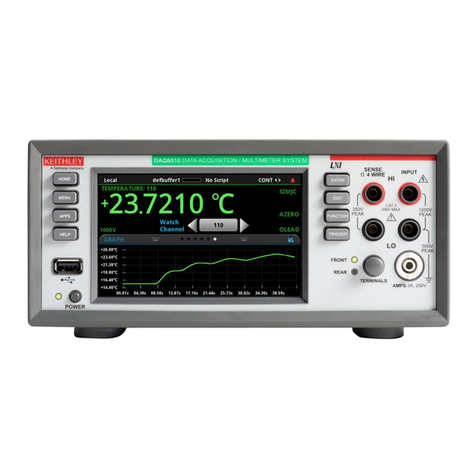
Keithley
Keithley DAQ6510 User manual

Keithley
Keithley DMM6500 User manual
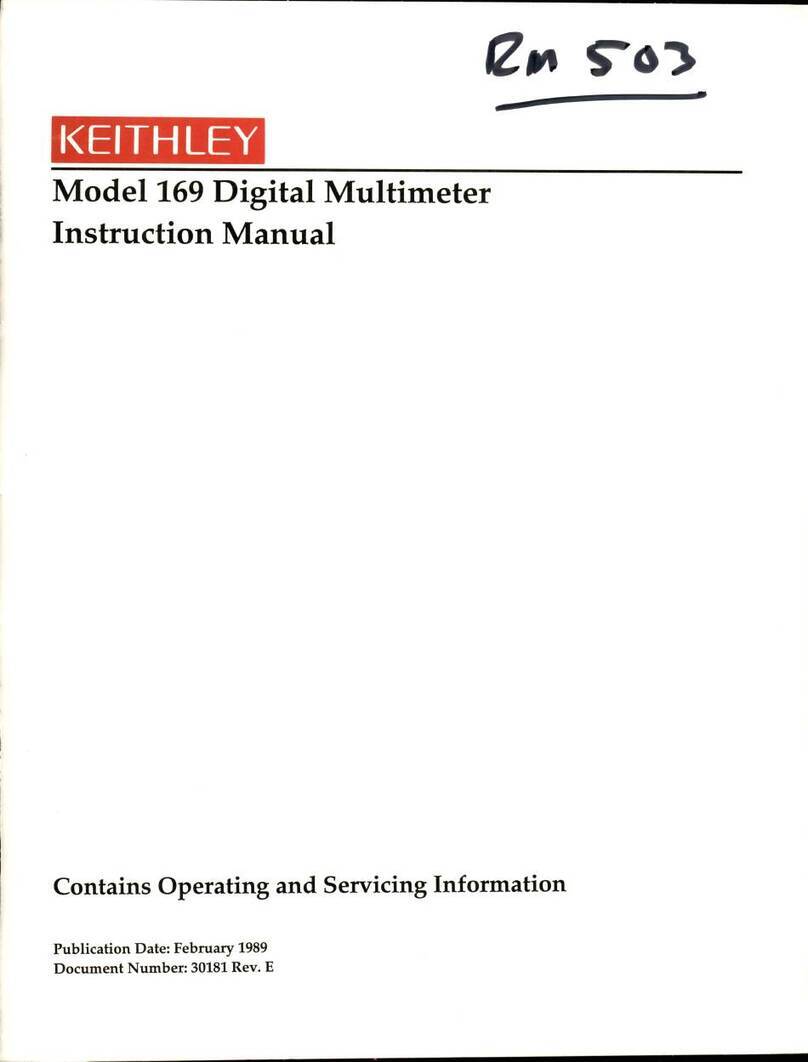
Keithley
Keithley 169 User manual
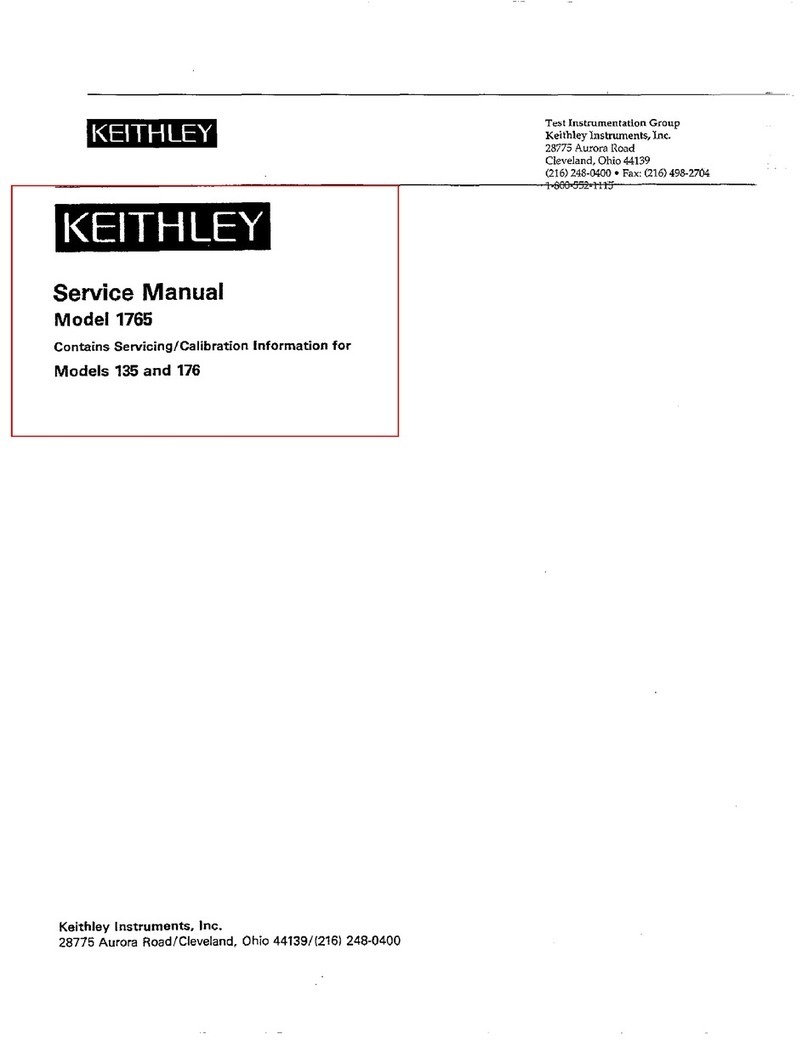
Keithley
Keithley 1765 User manual

Keithley
Keithley 2002 User manual
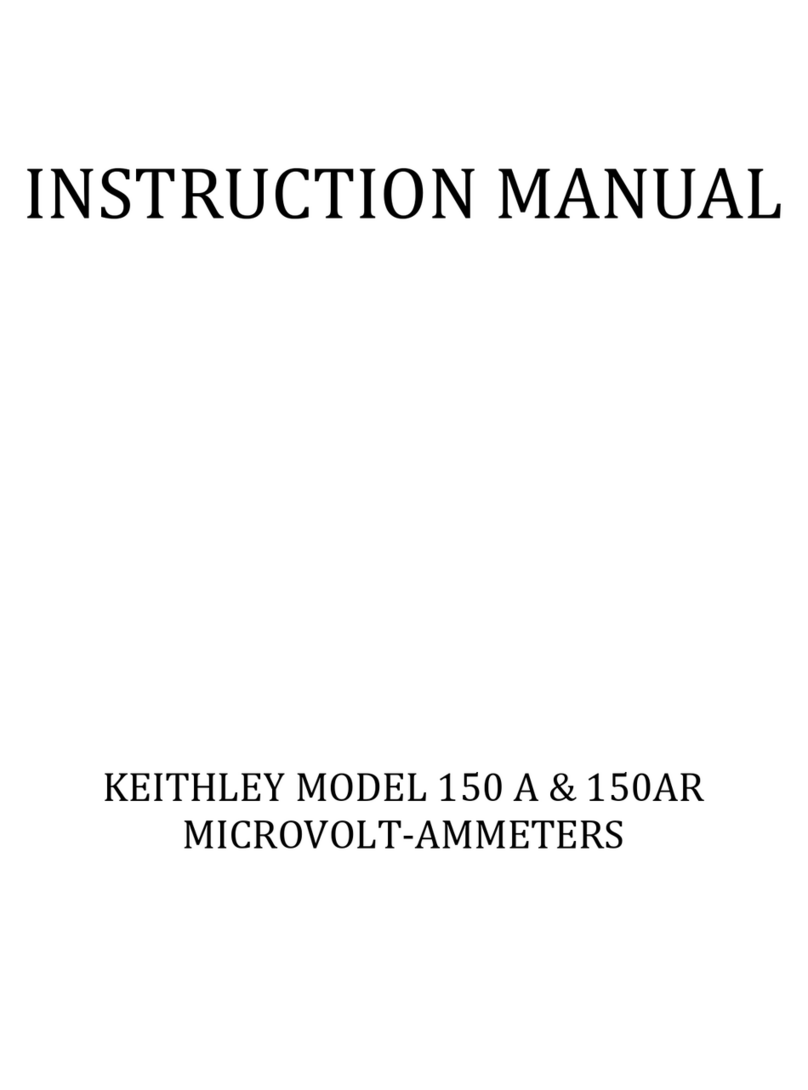
Keithley
Keithley 150 A User manual

Keithley
Keithley 2002 User manual

Keithley
Keithley 2010 User manual
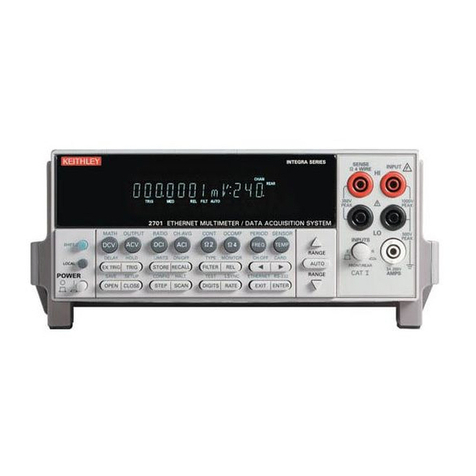
Keithley
Keithley 2701 User manual
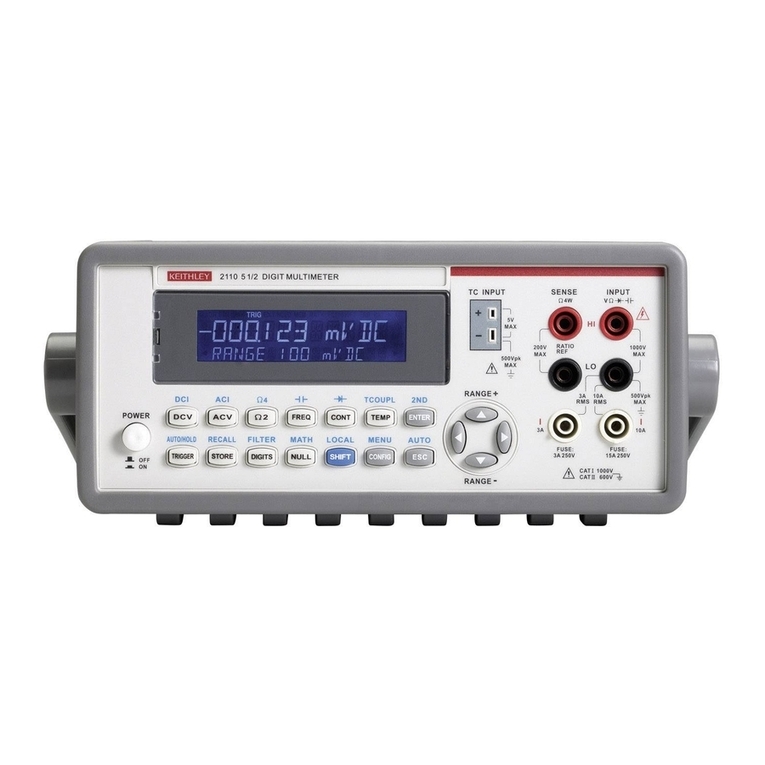
Keithley
Keithley 2110 User manual
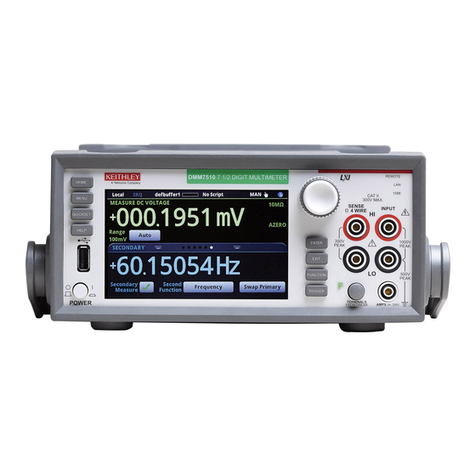
Keithley
Keithley DMM7510 User manual
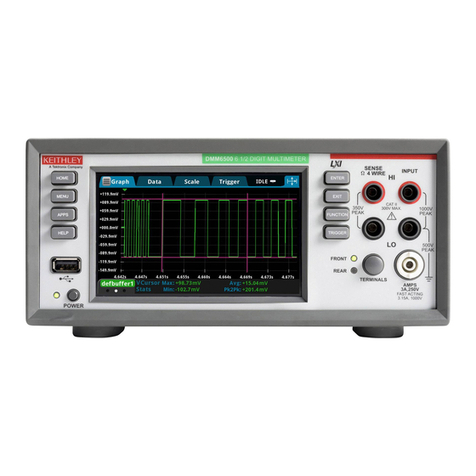
Keithley
Keithley DMM6500 User manual
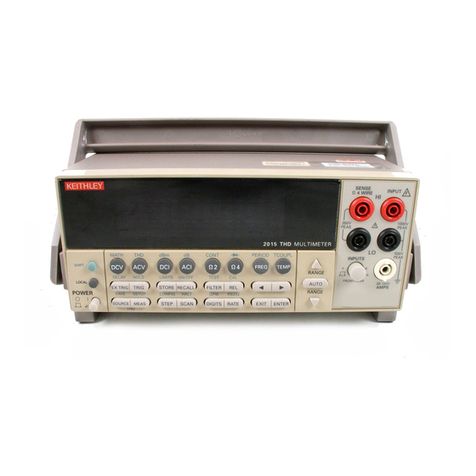
Keithley
Keithley 2015 User manual
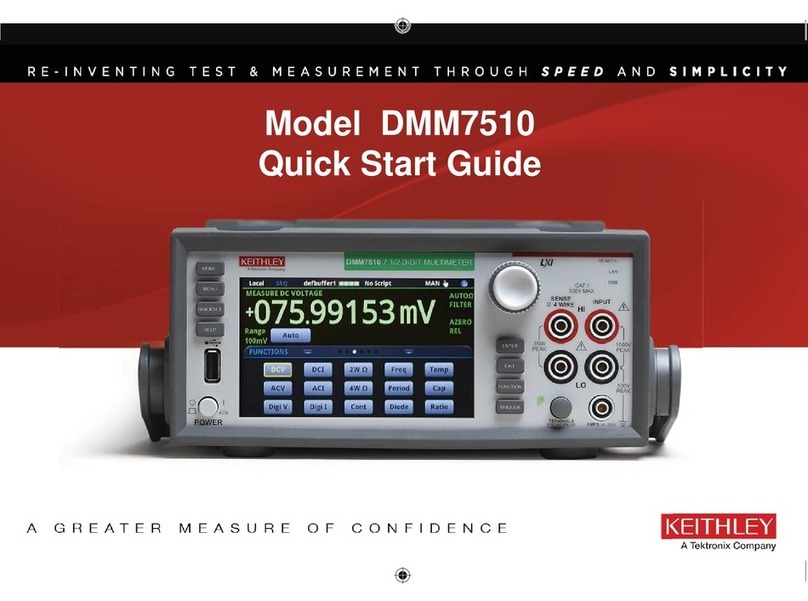
Keithley
Keithley DMM7510 User manual

Keithley
Keithley 2002 Use and care manual

Keithley
Keithley 172A User manual
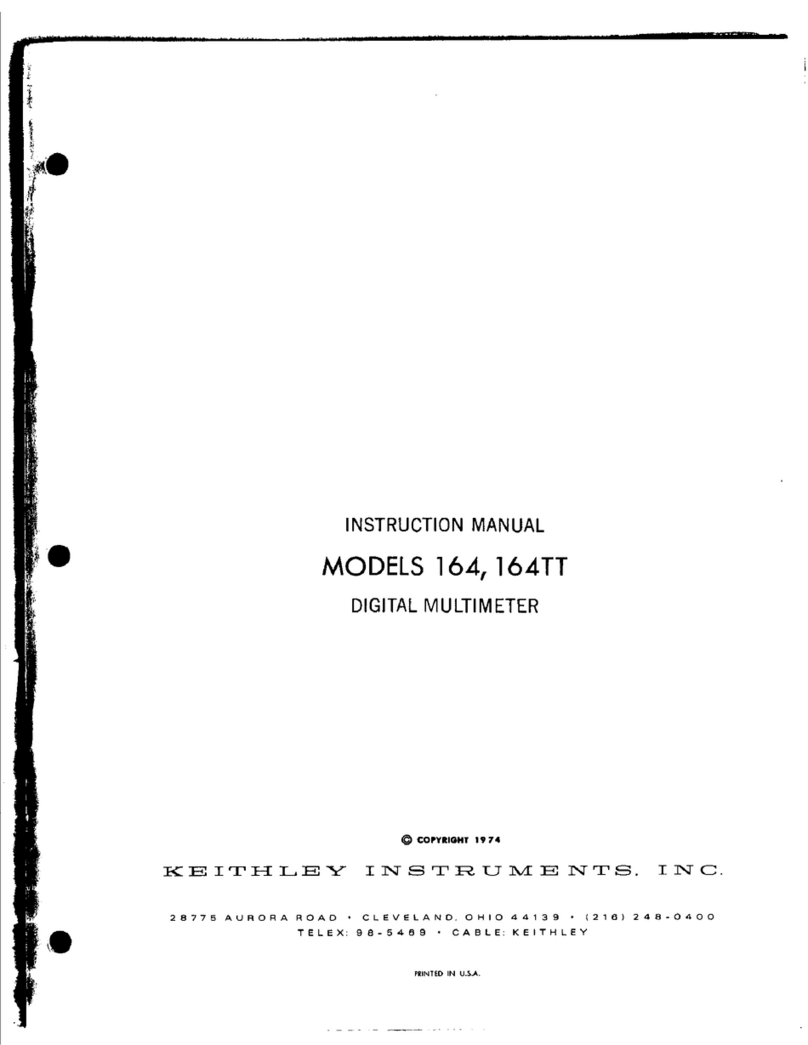
Keithley
Keithley 164 User manual

Keithley
Keithley 2001 User manual
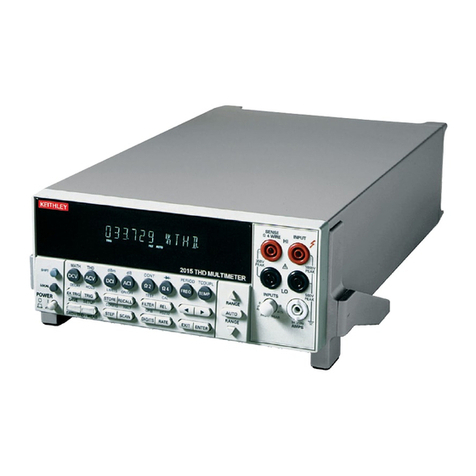
Keithley
Keithley 2016 User manual
